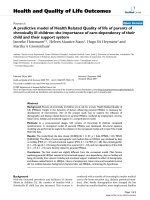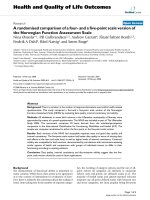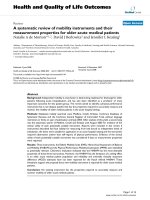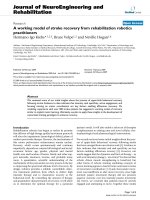báo cáo hóa học: " A case report of acute dermatitis that developed during an experiment examining the bromination of 3-hexylthiophene" potx
Bạn đang xem bản rút gọn của tài liệu. Xem và tải ngay bản đầy đủ của tài liệu tại đây (296.5 KB, 4 trang )
CAS E REP O R T Open Access
A case report of acute dermatitis that developed
during an experiment examining the bromination
of 3-hexylthiophene
Mikiya Sato
1,2
, Hajime Yoshiki
3
, Masaki Horie
4
, Eiji Yano
1,5*
Abstract
Occupational cases with allergic reaction to fragrance substances, which refer to various chemicals providing aroma
characteristics, are arising with its recent usage diversification from pharmaceutical, perfume industry to aromatic
remedies. However, chemicals responsible for fragrance allergy have hardly been identified because its component
is complex and its sensitization is not frequent. This report will present a case of acute allergic dermatitis that is
likely induced by 3-hexylthiophene, one of aromatic compounds often contained in fragrance substances. The case,
who was a 27-year male researcher engaged in organic chemical synthesis for six years, was exposed to 3-hex-
ylthiophene and its product (2-bromo-3-hexylthiophene) through an experiment in May 2004 and itching, swelling
and eczema immediately developed from face to back. This case of sensitization to 3-hexylthiophene suggests that
it be a possible allergen for fragrance allergy.
Background
Occupational cases of allergic dermatitis caused by aro-
matic compounds have been seen in the perfume indus-
try and among aromatherapists[1,2]. Sensitization to
aromatic compounds, although infrequent[3,4], has been
reporte d sporadically since the 1970s as allergies to rub-
ber products[5], anti-epileptic drugs[6], fragrance sub-
stances[7,8], and chemicals used in organic chemistry[9].
Common features of allergy to these are dermatitis on
the axillae, face, neck, wrists, and behind the ears and
hand eczema[3]. However, it has been d ifficult to iden-
tify the responsible chemicals from aromatic compounds
because of their complex contents.
In these settings, volatile odorous mixtures of aro-
matic compounds are generally used as essential and
fragrant oils. These oils often contain 3-hexylthiophene
[1,10], which is also an aromatic compound. Whilst 3-
hexylthiophene has recently been used to produce con-
ducting polymers, major occupational sites of exposure
to 3-hexylthiophene are the perfume industry and aro-
matherapy[1,2], where the number of workers using
these oils is increasing[1,4]. We experienced a case of
atopic dermatitis due to 3-hexylthiophene, which has
not been identified as a cause of acute dermatitis.
Case presentation
Case story
The patient was a 27-year-old male researcher who had
conducted research on organic chemical synthesis for
six years. Several years ago, he developed eczema acu-
tum on his face and neck during an experiment examin-
ing the synthesis of organic chemicals using ferrocene
(CAS number 102-54-5). He consulted a dermatologist
in a university hospital and was diagnosed with mild
atopic dermatitis due to chemical exposure; however,
the sensitizer was not identified in a multiple antigen
test. He had no other history of dermatological disease.
In May 2004, he conducted an experiment to examine
the bromination of 3-hexylthiophene (CAS number
1693-86-3). The experiment is described in detail else-
where[11]. He had performed the same experiment at a
smaller scale approximately two weeks before this epi-
sode, but had not suffered from any dermatitis.
On the morning of 14 May 2004 (day 1), he disso lved
3-hexylthiophene (95 mmol) in 150 ml of chloroform
(CAS number 67-66-3) and acetic acid (CAS number
64-19-7) in a 1:1 ratio by volume. The catalyst N-bro-
mosuccinimide (95 mmol; CAS number 128-08-5) was
* Correspondence:
1
Teikyo University School of Medicine, Department of Hygiene and Public
Health, Japan
Sato et al. Journal of Occupational Medicine and Toxicology 2010, 5:3
/>© 2010 Sato et al; licensee BioMed Central Ltd. This is an Open Access a rticle distributed unde r the terms of the Creative Commons
Attribution License ( which permits unrestricted use, dis tribution, and reproduction in
any me dium, provided the original work is properly cited.
added within 30 minutes with stirring. This process was
conducted in a fume hood at room temperature, while
the original experiment was performed at 0°C[11]. The
solution was stirred for 30 minutes. After he extracted
the products using a separating funnel in the afternoon,
the extract was washed with KOH solution (2 mol) and
diluted water, and then dried using a rotary evaporator.
The extraction and evaporation of solvent were per-
formed outside the fume hood for 30 minutes, although
a stopper was used for this operat ion. Immediat ely dur-
ing this process, itching and swelling spread from the
periocular skin over his entire face. Throughout the
experiment,heworegloves,alaboratorycoat,andgog-
gles, and noticed no odours. In the same laboratory,
another researcher condu cted another organic synthesis
experiment, but had no symptoms. The latter experi-
ment was conducted inside a d ifferent fume hood that
was sufficiently distant from the case to avoid exposu re.
By midnight, the rash a nd itching had spread over his
entire body. There were no systemic symptoms such as
vomiting, diarrhoea, dyspnoea, or wheezing.
On day 2, the chloroform was evaporated from the dry
extract using a rotary evaporator. The extract was
refined through a chromatography column filled with
silica gel and hexane, producing 59.4 mmol (63%) of 2-
bromo-3-hexylthiophene. Possible by-products of the
experiment were other hexylthiophenes, such as 2-
bromo-4-hexylthio phene, 3-bromo-4-hexylthiophene,
2,4-dibromo-3-hexylthiophene, 2,5-dibromo-3-hexylthio-
phene, 2,3-dibromo-4-hexylthiophene, and 2,4,5-tri-
bromo-3-hexylthiophene. The volumes of these
products were probably small.
The experiment was terminated on Day 3. His skin
symptoms worsened further (Figures 1 and 2). On Day 8,
a dermatologist diagnosed them as atopic dermatitis.
They were treated with an ointment and anti-allergic pills
beginning on Day 8. The eczema disappeared around Day
14, and he did not conduct any further experiments for
one month. No patch test or scratch test was adminis-
tered to detect a sensitizer. Since 2007, he has conducted
similar experiments using these chemicals, except 3-hex-
ylthiophene. No further dermatitis has developed.
Discussion
Except for the extraction process on Day 1, the experi-
ment was conducted in a fume hood with sufficient ven-
tilation (> 0.5 m/s). For protection, the patient had worn
gloves, a laboratory coat, and goggles. Nonetheless,
eczema acutum developed rapidly on his neck and back
immediately after he worked outside the fume hood on
Day 1. It is postulated that a small amount of vapour of
either the reagents used or the substances generated
during the experiment[12] (Table 1) caused his acute
dermatitis.
Figure 1 Eczema on the patient’s neck photographed on day 5.
Figure 2 Eczema on the patient’s back photographed on day 5.
Sato et al. Journal of Occupational Medicine and Toxicology 2010, 5:3
/>Page 2 of 4
The likely aetiology of the acute dermatitis in this case
was atopic dermatitis or irritant contact dermatitis.
Eczema may result from systemic, medication-induced,
physical, or psychological causes or xerosis or infections
[13]. However, these were unlikely because he did not
have a history of any of these diseases.
For a definitive diagnosis, a scratch test or patch test
is required, but they were not administered. We had to
rely on deductive inference instead. The rapid develop-
ment of eczema on his face and neck suggested either
atopic dermatitis due to type 1 hypersensitivity or irri-
tant contact dermatitis initially. The subsequent spread
of the rash and itching to his entire body, where direct
contact with any vapour was unlikely, indicated atopic
dermatitis due to type 4 hypersensitivity as well. The
rash on his skin was di agnosed as atopic dermatitis by a
dermatologist. It is likely that the main aetiology was
atopic dermatitis[14], although irritant contact dermati-
tis[15] may have preceded it.
3-Hexylthiophene, chloroform, and acetic acid evapo-
rate readily at room temperature[12] and he may have
been exposed to any of these. After this episode, how-
ever, he frequently used chloroform, acetic acid, and N-
bromosuccinimide in other organic syntheses w ithout
developing a rash. Thus, it was unlikely that these che-
micals, other than 3-hexylthiophene, were responsible
for the patient’s acute dermatitis.
Conclusions
Occupational cases of allergic dermatitis caused by aro-
matic compounds have been seen in the perfume indus-
try and among aromatherapists[1,2]. However, it
remains difficult to identify the chemica ls responsible of
dermatitis from the complex contents of volatile oils
[3,10,16]. This case suggests that hypersensitivity to 3-
hexylthiophene be a possible cause of aller gic dermatitis
induced by volatile oils.
Consent
The patient approved the publication of this episode,
but would not consent to any invasive procedure to
obtain a definitive d iagnosis. A copy of the written
consent is available for review by the editor-in-chief o f
this journal.
Author details
1
Teikyo University School of Medicine, Department of Hygiene and Public
Health, Japan.
2
Kawakita General Hospital, Centre for Family Practice, Tokyo,
Japan.
3
Riken, Safety Division, Japan.
4
The University of Manchester, UK.
5
Riken, Health Center, Japan.
Authors’ contributions
MS gave aethiological consideration, reviewed relevant literature, and
drafted the namuscript in English. HY drafted the manuscript in Japanese.
MH reported the case. EY gave supervision on this report from a perspective
of occupational hygiene. All authors read and approved the final manuscript.
Competing interests
The authors declare that they have no competing interests.
Received: 13 July 2009 Accepted: 27 February 2010
Published: 27 February 2010
References
1. Dharmagunawardena B, Takwale A, Sanders KJ, Cannan S, Rodger A,
Ilchyshyn A: Gas chromatography: an investigative tool in multiple
allergies to essential oils. Contact Dermatitis 2002, 47:288-292.
2. Keane FM, Smith HR, White IR, Rycroft RJ: Occupational allergic contact
dermatitis in two aromatherapists. Contact Dermatitis 2000, 43:49-51.
3. de Groot AC, Frosch PJ: Adverse reactions to fragrances. a clinical review.
Contact Dermatitis 1997, 36:57-86.
4. Paulsen E: Contact sensitization from Compositae-containing herbal
remedies and cosmetics. Contact Dermatitis 2002, 47:189-198.
5. Rudzki E: Pattern of hypersensitivity to aromatic amines. Contact
Dermatitis 1975, 1:248-249.
6. Conilleau V, Dompmartin A, Verneuil L, Michel M, Leroy D: Hypersensitivity
syndrome due to 2 anticonvulsant drugs. Contact Dermatitis 1999,
41:141-144.
7. Patlewicz GY, Wright ZM, Basketter DA, Pease CK, Lepoittevin JP, Arnau EG:
Structure-activity relationships for selected fragrance allergens. Contact
Dermatitis 2002, 47:219-226.
8. Sugiura M, Hayakawa R, Kato Y, Sugiura K, Hashimoto R: Results of patch
testing with lavender oil in Japan. Contact Dermatitis 2000, 43:157-160.
9. Fowler JF, Edge JC: Occupational airborne allergic contact dermatitis
from succinimidyl carbonates. Contact Dermatitis 2001, 45 :38.
10. Williams JD, Tate BJ: Occupational allergic contact dermatitis from olive
oil. Contact Dermatitis 2006, 55:251-252.
11. Higuchi H, Nakayama T, Koyama H, Ojima J, Wada T, Sasabe H: Synthesis
and properties of a, ω-disubstituted oligo (3-hexylthiophene)s and
oligothienoquinonoids in head-to-head orientation. Bull Chem Soc Jpn
1995, 68:2363-2377.
12. Sigma-Aldrich Structure Search. [ />chemical-synthesis/chemical-synthesis-catalog.html].
13. Rakel RE: Common dermatologic symptoms. In: Saunders Manual of
Medical Practice. Philadelphia, London, Toronto, Montreal, Tokyo. W.B.
Saunders 1996, 908-918.
Table 1 Properties of the materials used or generated during the extraction process [2].
Boiling point, °C Flash point °C Melting point °C Skin irritation Odor
N-Bromosuccinimide NA NA 180-183 + +
3-Hexylthiophene 65 37 NA + +
2-Bromo-3-
hexylthiophene
NA 110 NA NA +
Chloroform 62 NA -64 + +
Acetic acid 118 39 16.7 + +
NA: Not available
Sato et al. Journal of Occupational Medicine and Toxicology 2010, 5:3
/>Page 3 of 4
14. Rakel RE: Atopic dermatitis, Contact dermatitis. In: Saunders Manual of
Medical Practice. Philadelphia, London, Toronto, Montreal, Tokyo. W.B.
Saunders 1996, 919-920.
15. Rakel RE: Contact dermatitis. In: Saunders Manual of Medical Practice.
Philadelphia, London, Toronto, Montreal, Tokyo. W.B.Saunders 1996,
924-925.
16. Trattner A, David M, Lazarov A: Occupational contact dermatitis due to
essential oils. Contact Dermatitis 2008, 58:282-284.
doi:10.1186/1745-6673-5-3
Cite this article as: Sato et al.: A case report of acute dermatitis that
developed during an experiment examining the bromination of 3-
hexylthiophene. Journal of Occupational Medicine and Toxicology 2010 5:3.
Submit your next manuscript to BioMed Central
and take full advantage of:
• Convenient online submission
• Thorough peer review
• No space constraints or color figure charges
• Immediate publication on acceptance
• Inclusion in PubMed, CAS, Scopus and Google Scholar
• Research which is freely available for redistribution
Submit your manuscript at
www.biomedcentral.com/submit
Sato et al. Journal of Occupational Medicine and Toxicology 2010, 5:3
/>Page 4 of 4









